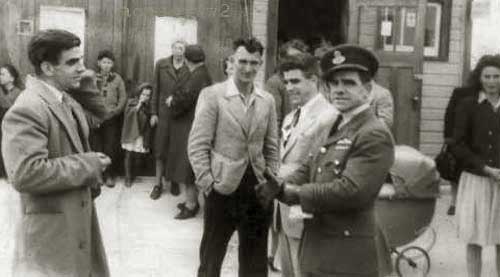For additional details see H.A. Halliday, The Tumbling Sky & Michel Lavigne, G/C A.U. “Bert” Houle (Lavigne Aviation Publications, Victoriaville) |
||||||||
_________________________________________________
Once Colleges Mat Champion, Massey Flier Awarded DFC
Ottawa, Dec. 3, 1942 - (CP) - Award of the Distinguished Flying Cross to Flying Officer Albert Ulrich Houle of Massey, Ont., for shooting down two enemy planes in Egypt was announced today by R.C.A.F. headquarters. The official citation covering the award follows One evening in October, 1942, Flying Officer Houle was flying with his squadron on patrol over El Alamein when a formation of enemy dive-bombers was sighted. The enemy aircraft jettisoned their bombs and flew west in an attempt to avoid the combat. With great tenacity and determination Flying Officer Houle pursued them far over the enemies' lines and in the rapidly failing light engaged and destroyed at least two of the hostile bombers. This officer is a skilful pilot who has always displayed exceptionally cool courage in action. His fine example has been a great inspiration to all personnel in his unit.” Born in Massey, Flying Officer Houle attended public and high school there before enrolling at the University of Toronto, where he graduated in science. For two years after graduation he was a demonstrator of electrical engineering at the university. Flying Officer Houle enlisted in the R.C.A.F. at North Bay, Ont. in September, 1940, received his wings at Moose Jaw, Sask., and has been overseas since May, 1941.. |
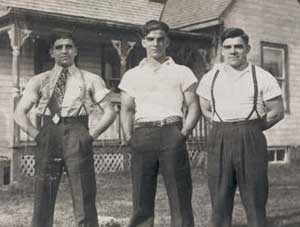 Brothers Tim, Lint & Bert Houle |
_________________________________________________
HOULE, F/O Albert Ulric (J4887) - Distinguished Flying Cross - No.213 Squadron
Award effective 1 December 1942 as per London Gazette dated 4 December 1942 and
AFRO 2069/42 dated 18 December 1942
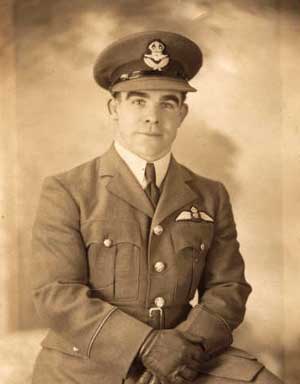 |
One evening in October 1942, Flying Officer Houle was flying with his squadron on patrol over El Alamein when a formation of enemy dive bombers was sighted. The enemy aircraft jettisoned their bombs and flew west in an attempt to avoid the combat. With great tenacity and determination, Flying Officer Houle pursued them far over the enemy's lines and, in the rapidly failing light, engaged and destroyed at least two of the hostile bombers. This officer is a skilful pilot who has always displayed exceptionally cool courage in action. His fine example has been a great inspiration to all personnel in his unit. NOTE: Public Record Office has message from Headquarters, RAF Middle East to Air Ministry, 26 November 1942 with original report: An immediate award of the DFC has been made to Flying Officer Albert Ulric Houle J4887 of 213 Squadron. On the evening of Monday, 26th October 1942 the squadron was out on patrol over El Alamein when a party of Junkers 87s was sighted in the distance. The time then was 1855 hours and the Stukas having jettisoned their bombs made off west as rapidly as possible. The squadron immediately dived to attack and Flying Officer Houle by his own courage and tenacity chased them far over enemy territory and in the rapidly failing light engaged and destroyed two Junkers 87s, probably destroyed one and damaged two more. Flying Officer Houle by this act displayed the typical qualities of cool courage and devotion to duty which are essentials of the first rate fighter pilot. These qualities have always been shown by this pilot and he has by his example improved the morale and aggressive qualities throughout his unit. His total score to date is three enemy aircraft destroyed, one enemy aircraft probably destroyed, three aircraft damaged. |
_________________________________________________
1943
_________________________________________________

22 January 1943, Western Desert, members of 145 Sqn. left to right - F/S E.A. Ker of Fenwick, Ontario; W/C I.R. Gleed, DSO, DFC, of London (England);
F/L A.U. Houle, DFC, of Massey, Ontario;
P/O J.W. Belse of Timmins, Ontario & F/L Gibson, the R.A.F. Adjutant
Canadian Flier Chalks Up Fine Record in Middle East
Cairo, 10 April 1943 - Formerly an instructor in electrical engineering at the University of Toronto and subsequently on the staff of International Nickel at Sudbury, 28-year-old F/L Albert Houle, of Massey, Ont., has done 230 hours of operational flying since being posted to the Middle East more than a year ago, and has chalked up a total of four enemy aircraft destroyed, one probably destroyed and three damaged.
His gong was an immediate award as a result of the achievement of getting two destroyed, one probable, and two damaged, all within the space of four minutes. This occurred when he took part in an attack on seven Stuka dive-bombers. During his many air battles, his aircraft has been several times holed, but he has escaped injury.
Another R.C.A.F. veteran of air warfare is Flight Sergeant Donald Gordon, of 3812 16th Avenue, Vancouver, whose operational hours have been divided into 45 in Britain, 15 in Ceylon and 55 on the desert. His claims total two 109's destroyed, one in England and one in Alamein. On the latter occasion, he and his No. 2 were attacked by a formation of enemy fighters and his No. 2 was shot down. He destroyed one and damaged another, but eight more swarmed around him like hornets, as all alone he fought his way homeward.
In Ceylon, he crossed aerial swords with the Japanese, and during the big raid last April he damaged a Zero fighter. He recalls that, of more than 80 Jap planes attacking, 27 were destroyed and as many more probably destroyed, while the R.A.F. lost only 16 aircraft and nine pilots. His chum, Pilot Officer James Whelan, of Vancouver, accounted for three of the Japs.
_________________________________________________
1944
_________________________________________________
Ontarian Scores In New Sector
With the 5th Army in Italy, Jan. 23, 1944 - (CP) - The
first victory over Nazi airmen seeking to attack the area south of Rome
invaded by 5th Army forces Saturday was scored by a Canadian Spitfire
pilot, Sqdn. Ldr. Bert Houle of Massey, Ont., when he shot down one of
four German planes which appeared over the area shortly after dawn.
Houle was leading a Canadian squadron on patrol over the invasion scene
when he encountered the enemy.
Altogether Allied fighters broke up six German attempts to attack the
men on the beaches and the ships of the invasion armada.
_________________________________________________
AIR UMBRELLA WELL PROVIDED BY CANADIANS
Ottawa, Jan. 28, 1944 - (CP) - Work of R.C.A.F. fighter
pilots in covering the British landings near Rome was a highlight of the
R.C.A.F. operational record during the last week, air force headquarters
reported today in its weekly summary.
The pilots were those of the City of Windsor Squadron, commanded by S/L
Albert Houle, D.F.C, of Massey, Ont., whose guns brought down the first
enemy plane over the British bridgehead.
Houle said the Canadians had a grandstand seat for the landing operations.
"From the air we certainly had the general impression that the entire
military operations was running on roller bearings,” he added. “Haze
prevented us seeing full details of activity on land but over the sea
clear visibility showed the colossal armada of landing barges, supply
ships and bigger craft."
Surprise Enemy Fliers
Early on the first day of the operation Houle, P/O Herbert Doyle of Montreal,
F/L Howard Sutton of Cortenay, B.C., and W/O Harry Johnson of Ottawa,
surprised a superior force of Focke-Wulfs sneaking in to dive-bomb the
landing parties. Despite the odds, the four Spits waded in and broke up
the enemy formation, the last air opposition encountered that day. The
Spits had complete mastery.
Other highlights in the operational record included:
In the Berlin attack on the night of Jan. 20-21 the R.C.A.F. bomber group
sent out more planes than it ever had used before on a single operation,
and they dropped the heaviest weight of bombs yet.
Enemy use of a rocket-like projectile, which opens in the air and has
a canister attached to a parachute, was reported by F/O S.S. Shulemson,
Montreal pilot, after an R.C.A.F. Beaufighter squadron of Coastal Command
attacked enemy shipping off the Norwegian coast.
Destroyer Set Afire
An enemy destroyer was set afire by bombs from an Albacore piloted by
F/O D.C. Thomson of Assiniboine, Alta., when the R.C.A.F. plane took two
Nazi destroyers by surprise in an estuary on the North European Coast.
The R.C.A.F. bomber group was out in full force for the attacks on Berlin
and Magdeburg, with the "Porcupine Squadron" making its debut
in the Berlin raid. On both nights German fighters were late tackling
the bomber formations.
A Halifax aircraft, piloted by F/L Frank Hurley of Winnipeg, a former
bush pilot, had nine encounters with enemy fighters in the two raids.
Canadian fighters were active in sweeps over France and brought down two
FW190's while escorting daylight bombers. An ME210 fell to the guns of
an R.C.A.F. Mosquito on night operations over France.
_________________________________________________
NINE CANADIANS CHASE 35 NAZIS
Damage at Least Five, Force Others to Flee
Allied Field Headquarters, Italy, Feb. 15, 1944 —
(BUP) — The City of Windsor Spitfire Squadron of the R.C.A.F. damaged
at least five enemy planes in a spectacular battle aver the Anzio bridgehead
yesterday in which nine Canadian planes tackled about 35 German craft.
The Canadians, flying in two small formations, headed by Squadron-Ldr.
Albert Houle, of Massey, Ont. and Flight-Lieut. Hedley Everard, of Timmins,
Ont., surprised a large formation of Focke-Wulfs and Messerschmitts preparing
to attack Allied shipping and troops at Anzio.
Both Canadian formations roared into the attack while troops on the ground
gazed spellbound and fearful at what looked like an impending disaster
for the attacking aircraft. But in spite of their great superiority, the
Germans went on the defensive and after a brief battle turned and headed
north.
_________________________________________________
ONTARIO AIRMAN PIONEERS QUEER AERIAL TACTICS
Has Close Call in Dive After Boches, But Gains Success
Somewhere In Italy, Feb. 22., 1944 - (CP) - At 29 years
of age, S/L Albert Houle, D.F.C., of Massey, Ont., officer commanding
the City of Windsor R.C.A.F. Spitfire Squadron fighting over the Anzio
bridgehead in Italy, has established a reputation in several fields.
He's noted as an administrator, a decisive leader in the air, a deadly
shot in combat and a crack soft-ball player — natural for a man
who distinguished himself in boxing, wrestling and rifle-shooting while
attending University of Toronto.
S/L Houle is credited with destroying nine enemy aircraft, probably destroying
two and damaging five. More than that, said S/L Ken MacGillivray in an
RCAF press dispatch today, Houle accidentally pioneered in a new kind
of aerial maneuver dubbed the "goggle dive.”
Dive After Stukas
He was leading a section of fighters at 12,000 feet when he spotted a
formation of Stukas far below. With his No. 2, F/S (now F/O) Bill Steele
of Toronto right behind him, Houle dived to the attack.
The coop-top of his Spitfire was open; and as he went screaming toward
the Stukas terrific suction plucked the goggles from his forehead and
held them above his head at the full extent of their straps.
When Houle reached up to slide the coop-top shut; the goggles jammed between
it and the frame, tilting his head up and backward. He tried desperately
to dislodge the goggles while in a headlong power dive, with Steele —
like a good No. 2 — sticking to his leader and asking no questions.
The planes plummeted for more than 11,000 feet; whistling smack through
the Stuka formation and on toward the wasteland below.
In Nick of Time
“Just in the nick of time,” said Houle, "I managed to
wrench my head free and pulled out of the dive at a bare 200 feet. It
was too close for comfort, but Steele stuck with me all the way."
Both' climbed back to the attack, this tune selecting Ju88's — vastly
more formidable aircraft than the Stukas. Houle shot one down with an
attack from astern and Steele was credited with the probable destruction
of another. This action was fought over El Alamein in September, 1942.
Since then Houle has flown and fought all the way from pre-Alamain days,
across Africa, in Malta, Sicily and Italy. He succeeded S/L (now W/C)
Stanley Turner, D.F.C. and bar, R.A.F., of Toronto,
in command of the only Canadian fighter unit in the Mediterranean theatre
of war.
Houle was awarded the D.F.C. in 1942 after destroying two Stukas; probably
destroying another and damaging two more over the British lines, at El
Daba.
_________________________________________________
ARMOUR PLATING IN PLANE SAVES LIFE OF AIRMAN
Brilliant Canadian Leader Has Narrow Escape Over Italy
 |
On the Anzio Beachhead, Italy, Feb. 29, 1944 —
(CP Cable) — S/L Bert Houle, D.F.C., of Massey, Ont., suffered a
wound in a recent dogfight over the beachhead, it was disclosed today,
a wound that came within a fraction of an inch of ending the brilliant
career of the fighter pilot who has led the City of Windsor Spitfire squadron,
RCAF, with spectacular success. A combination of fortitude and good flying of his damaged aircraft brought
him safely to base. Flies Home Alone |
_________________________________________________
Swetman Wins D.S.O., Houle Bar to D.F.C.
Ottawa, April 6, 1944 - (CP) - Two of the R.C.A.F.'s
top-flight operational leaders, who have been smashing the enemy by bomber
and fighter in two widely separated theatres of war, have been awarded
second decorations for outstanding work as squadron commanders, the R.C.A.F.
announced tonight.
They are W/C W.H. (Bill) Swetman, D.F.C., of Kapuskasing and Toronto,
leader of the Thunderbird bomber squadron, who has been awarded the Distinguished
Service Order, and S/L A.U. (Bert) Houle, D.F.C., of Massey, until recently
commander of the City of Windsor Squadron in Italy, awarded the Bar to
his D.F.C.
The R.C.A.F. also announced the award of DFC's to S/L Gordon B. Ough of
Newmarket, F/O C.L. Heide of Vancouver and F/O J.F.J. Roddick of Viking,
Alta.
Swetman, veteran of two complete tours of bomber operations, including
six attacks on Berlin and the 14th R.C.A.F. man to win the D.S.O., went
overseas as a sergeant pilot and quickly rose through the ranks to wing
commander. He won the D.F.C. in 1942 after a series of smashing raids
on Ruhr Valley targets.
While Swetman's squadron pounded targets in Central Europe, Houle led
his Spitfire squadron in repeated attacks against Axis air and ground
forces over Anzio, where he shot down five enemy planes to bring his score
up to "at least eight destroyed and others damaged."
Houle, who led his squadron through both the Sicilian and Italian campaigns,
has completed a tour of operational flying.
Ough has been serving with an Australian squadron operating against enemy
shipping and was once forced down on the sea with his crew. They were
picked up later by a destroyer.
Heide also is credited with "dinghy hours" in his citation,
which tells of his crew and himself spending three days in a dinghy following
a crash in enemy waters.
Roddick has been engaged on antisubmarine patrols, showing "great
courage, determination and devotion to duty."
_________________________________________________
HOULE, S/L Albert Ulrich (J4887) - Bar to DFC - No.417 Squadron
Award effective 30 March 1944 as per London Gazette dated 7 April 1944
and
AFRO 1020/44 dated 12 May 1944.
This commanding officer has served throughout the Sicilian and Italian campaigns. An excellent leader and skilful pilot, he has always evinced a fine fighting spirit, determination and courage. During the course of the fighting in Italy, Squadron Leader Houle destroyed five enemy aircraft, bringing his total victories to at least eight destroyed and others damaged.
NOTE: Public Record Office Air 2/9624 has recommendation drafted by the Officer Commanding, No.244 Wing and dated 4 February 1944 when he had flown 815 hours (133 in previous six months), 338 sorties (400 operational hours, of which 240 had been flown since previous award).
This officer has now completed 150 hours on his second tour and has commanded No.417 Canadian Squadron since November 21st 1943. Previous to this appointment he commanded a flight in the same squadron, and has fought throughout the Sicilian campaign and to date in the Italian invasion.
He has proved himself a most aggressive and capable fighter pilot and an excellent leader. Since fighting in Italy he has destroyed five enemy aircraft and damaged three more, bringing his total score to nine enemy aircraft destroyed, one probably destroyed and six damaged.
On 7 February 1944 the Air Officer Commanding, Desert Air Force, added his remarks:
Squadron Leader Houle is a very gallant fighter pilot and has done magnificent work, particularly since he took over command of No.417 Squadron. I strongly recommend him for the award of a Bar to his Distinguished Flying Cross.
_________________________________________________
Beurling, Houle Back With 200 Air Personnel
BY KENNETH C. CRAGG, OTTAWA, May 7, 1944 — From an airman's view — and he had a lot of it leading the City
of Windsor Spitfire Squadron over the Anzio Beachhead — S/L Albert
Houle believes the limited success of Allied arms there was due to the
speed with which the Germans moved supporting divisions into the threatened
section.
S/L Houle and F/L George (Buzz) Beurling, Verdun
Que., were two of 200 R.C.A.F. officers and men repatriated for leave,
to become instructors or ground crew who will train for air crew. Beurling
left the train at Montreal to visit his parents and will continue to Ottawa
tomorrow. He is back in Canada to teach his deadly deflection gunnery
skill to fledgling fighter pilots, but no announcement has been made as
to which station he will be posted.
Houle, born at Massey, Ont, back after the completion of two duty tours, said in as succinct comment as has ever come out of Italy, except what has been printed in the "Eighth Army News," of the Anzio situation: "They never believed they could move in so many so fast." He estimated the enemy moved in 12 divisions in 24 hours.
Houle, who comes of French-Canadian stock, is something of an authority in assessing a position - he has had a lot of experience in helping to chase the Hun up into Europe, from the time as an R.A.F. pilot he fought at Solum and kept on fighting all the way to Tripoli. In certain tangible ways he has left his imprint on the Middle East, not the least of them, by shooting down 11, getting a probable and damaging seven other enemy aircraft. He has a lot of other aircraft to his credit that he destroyed on the ground, but his record lumps them with a trail of wrecked motor transport and troop carrying trucks which he knocked off during Rommel's retreat from the gates of Alexandria.
The R.C.A.F. with its usual reticence, as a matter of fact modestly knocks down Houle as one of its most outstanding fighters. It is not surprising, therefore, that the stocky, black-haired 1936 Canadian intercollegiate wrestling champion in his own weight has built up a personal tradition. For example, he shot down two Jerries in 15 seconds.
That little feat he dismisses as just one of those things. As he tells it, he "squirted" at one, and he went down underneath him, and as No. 1 fell away, there was another Jerry beyond him, and he "squirted" him and that was all there was to it.
|
Oakwood, S.P.S. Grad Knows What Fritzes Think In a generally reminiscent mood, Houle ventured that Wing Cmdr. Stanley (Bull) Turner of Toronto knows more than any one else about air fighting. He said Turner had flown more than 1,000 operational hours, and has been in so long "he practically knows what a German is going to do - even what he's thinking about." Both Houle and Sinclair, spoke with warm affection about FO, Bill (Lefty) Steele of Toronto. Steele, they averred, used to play in a Salvation Army band. Steele, they said, still keeps a horn and said he played hymns and other tunes for the squadron. He has a line on corny jokes and you can't discourage him. After a particularly sticky do, MacGillivray always seemed to be in there helping." Stocky, with bushy black eyebrows, and a serious talker, Houle answered questions on various phases of the Mediterranean campaign, which he followed from the dark days of Rommel's successes to the bright days of Gen. Sir Bernard Montgomery's big push to Italy. |
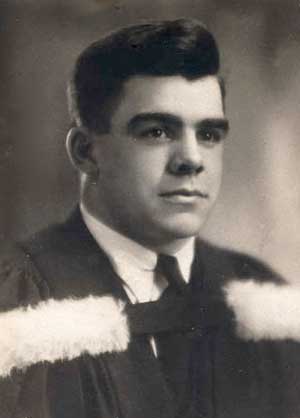 Bert Houle the Graduate |
"Those were the days when an old model Hurricane was our first line fighter and when other types long since out of service made up our strength," he said, "Those were also the days when we had orders not to waste ammunition and to make every shot count."
He told of the assembly of out dated planes, of how they were loaded down with bombs, and of how they flew continuously over the Germans and Italians until they were stopped in their tracks.
Only 250 Bombs Left
"When that time came we had exactly 250 bombs left," Houle recalled.
FO. Rick (Snake) Rattle, Toronto, another veteran of North Africa in the
party, said that one type of aircraft called into service at that time
was the Bombay bomber, "an old crate from away back."
He added with a chuckle:
"The boys used to line up their bombs along the floor, and when they
were over the target they would open a back door, nose the plane up slightly
and the bombs would roll out. No sir, they didn't have any fancy bombsights,
and everybody used to laugh when the bomb aimer would yell officially,
but with little confidence, 'Bombs gone, sir.'"
The aimer would then heave over an empty bottle which would whine earthward
with the noise of a blockbuster.
Houle said that he bad noticed varying changes in German tactics during
the last year.
"In the early days we were outnumbered and we used to have to fight
our way out of some pretty tough spots," he said. "But gradually
as our power increased and German morale and pilot material seemed to
fall away we used to spend our time chasing them." He said that lately
the German strategy seemed to be to nurture dwindling strength. Pilots
apparently had orders not to mix it with Allied airmen because they couldn't
afford losses.
Chased Foe Out of Sky
He said the only time that the Germans concentrated air support over their
armies was when the ground forces needed support, such as during the Battle
of Ortona.
"They swarmed at us in fairly large numbers," he recalled. "But
we soon had the edge on them, and finally chased them out of the sky.
Either our equipment had vastly Improved or their pilots were becoming
worse,"
Houle said similar German strategy was employed at the Anzio Beachhead,
where his squadron recently had been employed.
"However, they seem to be using more experienced pilots in this area,
and they are trying to make a fight of it and giving us some pretty tough
battles," he said. "However, our planes are better than theirs,
and it's only a question of time before we knock them out."
Houle was met at the disembarkation port by his mother, who made her first
flight to be there.
_________________________________________________
Behind The Lines
May 23, 1944 - Squadron-Ldr. Bert Houle, D.F.C. and bar, formerly commanding officer of the City of Windsor squadron, was a visitor in Hamilton yesterday. His record includes 11 enemy planes shot down. Squadron-Ldr. Houle visited Mr. and Mrs. W. J. Warnick, 133 Stinson Street, with whose son, Ambrose, he graduated at Moose Jaw three years ago. Ambrose has been stationed in the Far East until recently. He met Squadron-Ldr. Houle in England as the Windsor commander was returning to Canada. Parents of a number of local airmen serving in the City of Windsor squadron met the distinguished flyer here yesterday
_________________________________________________
Victories Include :
| 1 Sep 1942 4 Sep 1942 26 Oct 1942 13 Nov 1942 8 Jan 1943 4 Oct 1943 3 Dec 1943 22 Jan 1944 27 Jan 1944 28 Jan 1944 7 Feb 1944 14 Feb 1944 |
one Ju88 one Me109 two Ju87s one Ju87 two Ju87s 1/2 Fi156 one Me109 one FW190 two FW190s two Me109s one FW190 one Me109 one Me109 one Me109 one FW190 one FW190 one FW190 |
destroyed damaged destroyed, probable & damaged destroyed destroyed destroyed & damaged destroyed destroyed destroyed & damaged destroyed * destroyed destroyed & damaged |
213 Sqn 213 Sqn 213 Sqn 213 Sqn 145 Sqn 417 Sqn 417 Sqn 417 Sqn [1] 417 Sqn [2] 417 Sqn 417 Sqn 417 Sqn |
11.5 / 1 / 7
* Claimed as a squadron victory & not counted
| [1] (Spitfire JF457, A/417). Time up 0740 hours, time down 0930 hours (110 minutes); weather clear and Map Reference Rome 1:500,000, second edition, NE.40/10. “Patrol Ground troops and invasion barges.” 0840 hours - 12,000 feet - Anzio: I was leading eight aircraft call sign “Brandy” at twelve thousand feet. Ground station “Earthwork” had reported bandits in the vicinity. I saw four aircraft in line astern formation 6,000 feet below, one which looked suspicious. I started down to investigate, then saw them drop their bombs. I gave the order to drop long range tanks and dove down behind the four FW.190s. I took a short burst at the last one with no visible results at about 150 yards. I closed in to about 100 yards and got in another second burst. Black smoke poured from his aircraft and I saw many strikes around the engine and fuselage and wing roots. At the same time a 190 got on my tail and my aircraft was hit in three places. I broke starboard into a squadron of Kittyhawks so climbed back on patrol. I did not see the FW.190 go in. 79 Group confirmed this FW.190 as also did Brandy Red Four. I claim one FW.190 destroyed. 0930 - Base: Aircraft landed. Own aircraft damaged (Category III). “Part B” F.A. - Enemy aircraft over Anzio (Italy) [2] Spitfire JF936 (A/417). Time up 0935 and Time down 1130 hours (115 minutes), no cloud and good visibility. Airfield was Marsianise, Map Reference Rome 1:500,000, second edition, N.W. 40/10. “Patrol Beaches" (Anzio) “Part B” F.A. - Enemy aircraft over Anzio (Italy) |
_________________________________________________
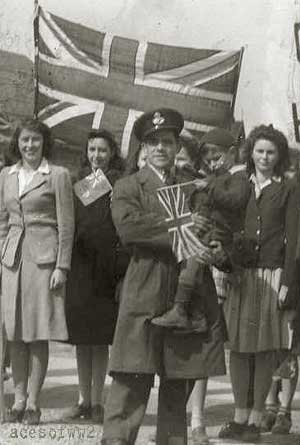 |
Bert HouleWelcome Home to Massey |
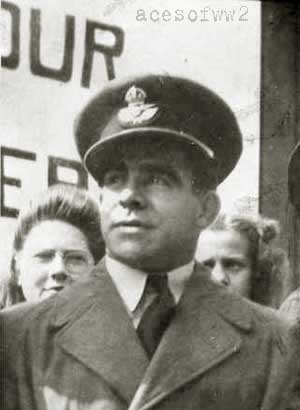 |
_________________________________________________
|
 |
_________________________________________________
Related Sites : |
_________________________________________________
Thanks go out to
Paul & Craig Houle for the photos & infos !
On these pages I use Hugh Halliday's extensive research which includes info from numerous sources; newspaper articles via the Canadian Museum of Civilization Corporation (CMCC); the Google News Archives; the London Gazette Archives and other sources both published and private.
|
Some content on this site is probably the property of acesofww2.com unless otherwise noted.
![]()


